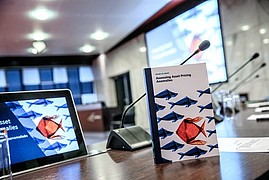PhD Defence: Wilma de Groot

In her dissertation ‘Assessing Asset Pricing Anomalies’ Wilma de Groot wants to gain more and better insight into possible explanations for well-known asset pricing anomalies.
Wilma defended her dissertation in the Senate Hall at Erasmus University Rotterdam on Thursday, 21 December 2017 at 15:30. Her supervisors were <link people marno-verbeek>Prof. Marno Verbeek and Prof. Jules van Binsbergen. Other members of the Doctoral Committee are Prof. Philip Stork (VU), <link people patrick-verwijmeren>Prof. Patrick Verwijmeren (EUR), <link people marta-szymanowska>Dr Marta Szymanowska (EUR).
About Wilma de Groot

Wilma de Groot (1979) studied Econometrics and Operations Research at Tilburg university from 1997 to 2001. After receiving her Master degree in 2001 she joined Robeco as a Quantitative Researcher, focusing on equity research. Soon afterwards, Robeco introduced its first purely quantitative equity strategy for which Wilma developed the portfolio construction software. Fifteen years later, this business had grown to around 40 billion euros assets under management. As a spin-off of her research Wilma has published papers in the Journal of Banking and Finance, Journal of Empirical Finance, Financial Analysts Journal, Journal of Alternative Investments, Pensions and the VBA Journaal. Her studies have been presented at several international conferences and she has regularly given lectures at several universities. In 2008 she finished the education for Charted Financial Analyst at the CFA institute and is a CFA charter holder. Since 2014 Wilma is a Portfolio Manager within the Core Quant Equities team of Robeco.
Wilma’s research interests include factor investing strategies. Besides her experience on this topic applied to equities she also has several publications in the field of commodity research. In addition, she has a broad interest in pension fund cases, which she experiences as board member of the Robeco Pension Fund (since 2013) and member of the Investment Committee.
Thesis Abstract

One of the most important challenges in the field of asset pricing is to understand anomalies: empirical patterns in asset returns that cannot be explained by standard asset pricing models. Currently, there is no consensus in the academic literature on the underlying causes of well-known anomalies, such as the value and momentum anomalies. Anomalies could be the result of data mining, disappear when trading costs are taken into account, be a compensation for a particular form of risk, or have a behavioral explanation. The motivation of this research project is to gain more and better insight into possible explanations for well-known asset pricing anomalies. Understanding asset pricing anomalies is of the utmost importance for investors. It allows them to make better informed investment decisions, and thereby achieve higher return premiums.
The first study in this dissertation shows that the value, momentum and size anomalies are also present in the new emerging equity markets, the so-called frontier emerging markets, which makes data mining as an explanation for these anomalies unlikely. The second study focuses on trading costs as a possible explanation for the short-term reversal anomaly. Focusing on large-cap stocks and applying a more sophisticated portfolio construction algorithm lower trading costs significantly, such that reversal strategies generate profitable results net of trading costs. The third study examines risk as an explanation for the value and size anomalies. Although value and small-cap exposures are typically associated with distress risk, the results indicate that distress risk is not priced and that the small-cap and value premiums are priced beyond distress risk. The fourth and last study examines a behavioral explanation for the low-risk anomaly. Based on a general equilibrium model, tournament behavior causes the returns of low-risk (high-risk) assets to be larger (smaller) than expected according to the Capital Asset Pricing Model. In addition, empirical analyses confirm a positive and significant relation between tournament behavior and the low-risk premium
Photos: Chris Gorzeman / Capital Images


